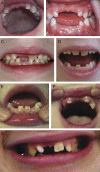Clinical spectrum of 4H leukodystrophy caused by POLR3A and POLR3B mutations
- PMID: 25339210
- PMCID: PMC4248461
- DOI: 10.1212/WNL.0000000000001002
Clinical spectrum of 4H leukodystrophy caused by POLR3A and POLR3B mutations
Abstract
Objective: To study the clinical and radiologic spectrum and genotype-phenotype correlation of 4H (hypomyelination, hypodontia, hypogonadotropic hypogonadism) leukodystrophy caused by mutations in POLR3A or POLR3B.
Methods: We performed a multinational cross-sectional observational study of the clinical, radiologic, and molecular characteristics of 105 mutation-proven cases.
Results: The majority of patients presented before 6 years with gross motor delay or regression. Ten percent had an onset beyond 10 years. The disease course was milder in patients with POLR3B than in patients with POLR3A mutations. Other than the typical neurologic, dental, and endocrine features, myopia was seen in almost all and short stature in 50%. Dental and hormonal findings were not invariably present. Mutations in POLR3A and POLR3B were distributed throughout the genes. Except for French Canadian patients, patients from European backgrounds were more likely to have POLR3B mutations than other populations. Most patients carried the common c.1568T>A POLR3B mutation on one allele, homozygosity for which causes a mild phenotype. Systematic MRI review revealed that the combination of hypomyelination with relative T2 hypointensity of the ventrolateral thalamus, optic radiation, globus pallidus, and dentate nucleus, cerebellar atrophy, and thinning of the corpus callosum suggests the diagnosis.
Conclusions: 4H is a well-recognizable clinical entity if all features are present. Mutations in POLR3A are associated with a more severe clinical course. MRI characteristics are helpful in addressing the diagnosis, especially if patients lack the cardinal non-neurologic features.
© 2014 American Academy of Neurology.
Conflict of interest statement
N. Wolf serves as communicating editor of the
Figures



Comment in
-
Little folks, little myelin, and little teeth.Neurology. 2014 Nov 18;83(21):1884-5. doi: 10.1212/WNL.0000000000001010. Epub 2014 Oct 22. Neurology. 2014. PMID: 25339215 No abstract available.
References
-
- Wolf NI, Harting I, Boltshauser E, et al. . Leukoencephalopathy with ataxia, hypodontia, and hypomyelination. Neurology 2005;64:1461–1464. - PubMed
-
- Wolf NI, Harting I, Innes AM, et al. . Ataxia, delayed dentition and hypomyelination: a novel leukoencephalopathy. Neuropediatrics 2007;38:64–70. - PubMed
Publication types
MeSH terms
Substances
Supplementary concepts
Grants and funding
LinkOut - more resources
Full Text Sources
Other Literature Sources
Medical
Molecular Biology Databases
